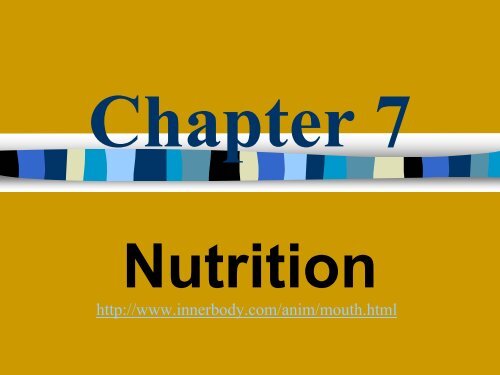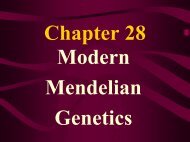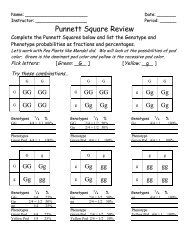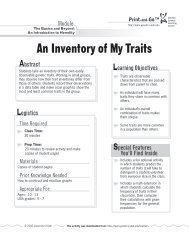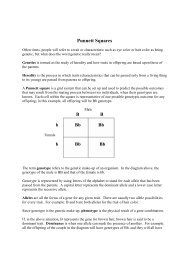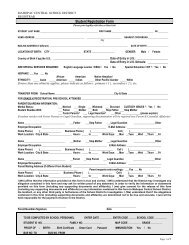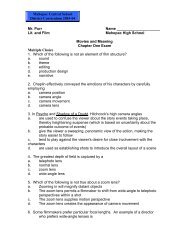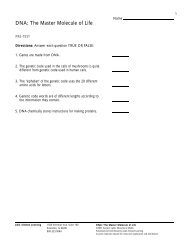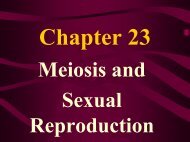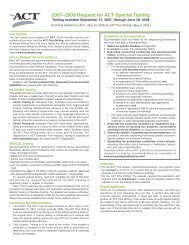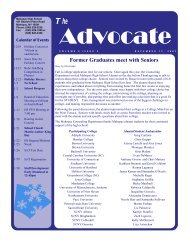Chapter 7
Chapter 7
Chapter 7
Create successful ePaper yourself
Turn your PDF publications into a flip-book with our unique Google optimized e-Paper software.
<strong>Chapter</strong> 7<br />
Nutrition<br />
http://www.innerbody.com/anim/mouth.html
Nutrition<br />
•The activities by which an<br />
organism obtains,<br />
processes, and uses food<br />
to carry on their life<br />
functions<br />
http://home.socal.rr.com/exworthy/anatrtion.htm#Nutrition
Two Types of Nutrition<br />
1. Heterotrophic Nutrition<br />
2. Autotrophic Nutrition
(I) Autotrophic Nutrition<br />
•A type of nutrition in which<br />
an organism can make its<br />
own food<br />
•Ex: green plants<br />
algae<br />
some bacteria
Autotroph<br />
•An organism capable of<br />
making their own food
Photosynthesis<br />
•The most common type of<br />
autotrophic nutrition<br />
•In this process, organisms<br />
use energy from sunlight,<br />
carbon dioxide, and water<br />
to make its own food
Photosynthesis<br />
http://www.salineschools.com/users/diabt/diab.html
Chloroplast<br />
•Contains a green pigment<br />
called chlorophyll<br />
•It is in the chloroplast that<br />
light energy is trapped by<br />
chlorophyll and glucose is<br />
formed as the product (food)
Structure of Chloroplast
Formula for Photosynthesis<br />
6 CO2 + 12 H20 C6H12O6 + 6 H20 + 6 02
ROY G BIV<br />
• The maximum amount of<br />
photosynthesis will occur when<br />
exposed to red and blue light<br />
because it is these two colors<br />
that are easily absorbed in great<br />
quantity by the chlorophyll<br />
• For green leaves, green light is<br />
reflected and therefore has the<br />
least affect on photosynthesis
ROY G BIV
ROY G BIV
Photosynthesis occurs in two<br />
stages:<br />
1. Light Reaction<br />
2. Dark Reaction
1. Light Reaction<br />
1. Occurs in the grana of the chloroplast<br />
2. First stage of photosynthesis<br />
3. Begins with the absorption of light<br />
energy by chlorophyll<br />
4. Photolysis occurs- a reaction in which<br />
H2O molecules split into oxygen and<br />
hydrogen<br />
5. All oxygen given off during<br />
photosynthesis comes from the<br />
photolysis of water<br />
6. ATP (Adenosine triphosphate), which is<br />
a form of energy, is produced
Light Reaction
2. Dark Reaction<br />
• Occurs in the stroma of the chloroplast<br />
• The second stage of photosynthesis<br />
• It is here that CO2 is converted to<br />
carbohydrates by a process called carbon<br />
fixation<br />
• Light is not required<br />
• The dark reaction does not require ATP to<br />
take place
Dark Reaction
Factors Affecting the Rate of<br />
Photosynthesis<br />
1. Light Intensity<br />
2. Water<br />
3. Carbon dioxide level<br />
4. Temperature
Adaptations for Photosynthesis<br />
A. Unicellular Organisms<br />
1. Almost all chlorophyll-containing<br />
unicellular organisms are aquatic (live in<br />
water)<br />
2. The raw materials for<br />
photosynthesis are absorbed directly<br />
from the water and into the cell<br />
Ex: algae
B. Terrestrial Plants (land-dwelling)<br />
1. Occurs in leaves that provide<br />
the maximum surface area for the<br />
absorption of light
Cross section of Leaf (ditto)<br />
1. Outer most layer is the epidermis<br />
which is covered by a waxy coat<br />
called the cuticle – which prevents<br />
excess water loss<br />
2. Stomates- allows the exchange of<br />
O2 and CO2 between the leaf and<br />
the external environment
3. Guard cells- control the<br />
opening and closing of the<br />
stomates<br />
4. Palisade Layer- is where most<br />
of photosynthesis takes place<br />
5. Vein- contain xylem and<br />
phloem (known as vascular<br />
tissue)
Chemosynthesis<br />
• A type of autotrophic nutrition<br />
• Does not require light as an<br />
energy source<br />
• Energy is obtained by chemical<br />
reactions within the cell
(II) Heterotrophic Nutrition<br />
•These are organisms that can<br />
not make their own food<br />
•Therefore they have to obtain<br />
it from the environment<br />
•IngestionDigestion<br />
Egestion
Ingestion<br />
•The taking in of food<br />
into the body
Ingestion
Ingestion
Digestion<br />
•The process by which<br />
large molecules are<br />
broken down into<br />
smaller molecules that<br />
can be used by the cells.
Four types of digestion:<br />
1. Intracellular digestion- takes place<br />
inside the cell (no digestive tract)<br />
Ex: simple, unicellular organisms<br />
and plants<br />
2. Extracellular digestion- takes place<br />
outside of the cell and usually in a<br />
digestive tract<br />
Ex: animals
3. Mechanical digestion- the increase<br />
in surface area of food by<br />
physically grinding and cutting<br />
food into smaller pieces Ex:<br />
chewing food with teeth<br />
4. Chemical digestion- Large food<br />
molecules are broken down into<br />
smaller ones by the use of enzymes<br />
(Hydrolysis)
Egestion<br />
•The elimination of undigested<br />
food from the body in the<br />
form of feces.<br />
•Do not confuse with<br />
excretion, which is the<br />
removal of cellular wastes<br />
and not undigested food
Nutrients<br />
And their<br />
Building Blocks
Carbohydrates<br />
•main source of energy for<br />
cell activities<br />
•glucose molecules are the<br />
building blocks of<br />
carbohydrates
Lipids<br />
•commonly known as fats<br />
•source of stored energy in<br />
living organisms<br />
•The building blocks for<br />
lipids are 3 fatty acids and<br />
1 glycerol molecule
Proteins<br />
•along with lipids, protein<br />
molecules make up part of<br />
the cell membrane<br />
•amino acids are the<br />
building blocks of proteins
Dehydration<br />
Synthesis<br />
vs.<br />
Hydrolysis
Dehydration Synthesis<br />
• the process in which two molecules<br />
are joined together, with the help of<br />
enzymes, to form a larger molecule<br />
plus water<br />
Ex:<br />
glucose + glucose = maltose + water
Dehydration synthesis is a type<br />
of reaction in which two<br />
molecules are bonded together<br />
by the removal of water. Joining<br />
two<br />
monosaccharides by<br />
dehydration synthesis forms a<br />
disaccharide like maltose or<br />
sucrose. Many organic<br />
compounds are polymers that<br />
have long chains of repeating<br />
units. A polymer formed by<br />
joining many sugar molecules<br />
end to end is called a<br />
polysaccharide.Starch,
Hydrolysis<br />
• is the opposite of dehydration<br />
synthesis<br />
• hydrolysis is the process in which<br />
large molecules are broken down<br />
into smaller ones by the addition of<br />
water and enzymes<br />
Ex:<br />
maltose + water = glucose + glucose
Enzymes<br />
• Are known as a catalyst<br />
• All enzymes end in ase<br />
Ex: substrate<br />
maltose <br />
lipid <br />
enzyme<br />
maltase<br />
lipase<br />
• Enzymes regulate the rate at which<br />
reactions occur
Enzy m es are large, co mplex proteins.<br />
They make itpossible for chemical<br />
reactions to occur in living cells.They are<br />
organic catalysts, because they can<br />
affecta reaction without being changed<br />
itself.An enzyme acts upon a substrate.<br />
The names ofthe enzymes usually ends<br />
with the suffix ase, and the name is<br />
often derived from the substrate.For<br />
example, maltase is the enzy me that<br />
splits one maltose m olecules into two<br />
glucose ones.
Lock-and-Key Model<br />
• substrate- material to which the enzyme<br />
attaches to (see diagram)<br />
• only certain enzymes can break down<br />
certain substrates<br />
• after the enzyme attaches to the substrate,<br />
an enzyme-substrate complex is formed<br />
• the substrate is then broken down into<br />
smaller molecules
Somewhereon the surface of an enzyme,<br />
there isan active site. The substrate<br />
moleculesfitthe shape ofthe active site.It<br />
then forms atemorary union with the<br />
enzymecalled the enzy me-substrate<br />
complex.The substrate may then break<br />
bonds within the substrate moleculeand thus<br />
separateitinto two smallermolecules. This<br />
iscalled the lock-and-key model because the<br />
notched surface of a key can open only one<br />
lock,justlike the shape ofthe active site of<br />
an enzyme fitsthe shape ofonly certain<br />
substrates.
Factors that Influence<br />
Enzyme Action<br />
• Temperature- as you increase<br />
temperature, enzyme action will increase<br />
until an opitmum temperature of 37<br />
degrees Celsius is reached<br />
• Enzyme-Substrate Concentration-<br />
1. High levels of enzyme + low levels of<br />
substrate = an increase in enzyme action<br />
2. Low levels of enzyme + high levels of<br />
substrate = a decrease in enzyme action<br />
• pH- affects enzyme action. Some<br />
enzymes work better in an acidic


